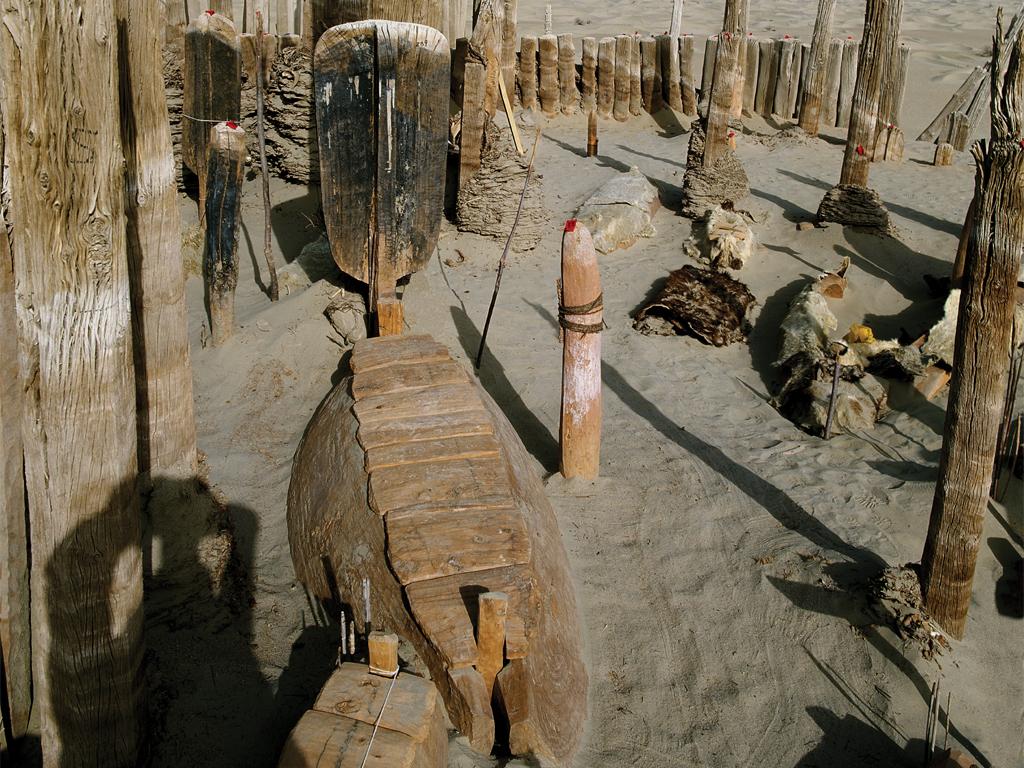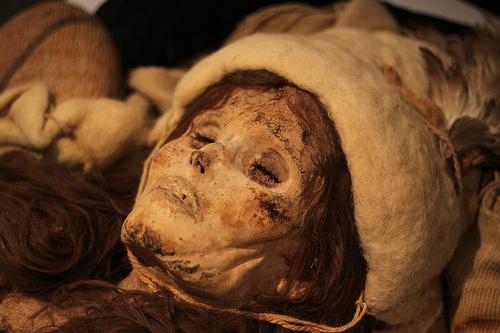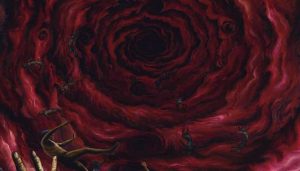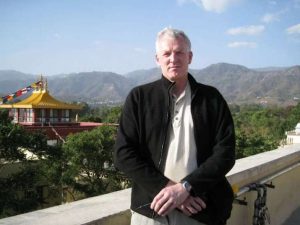Amidst the harshness and death of the desert, a remarkably well-preserved cadaver (1800–500 BCE) was found in 2006 at the Xiaohe necropolis near Lop Nur, southeast Xinjiang. The unearthly, arresting “Beauty of Xiaohe” was so expertly preserved by the arid climate and alkaline soil that she seems to be merely napping in her feathered felt hat, fur-lined leather boots, and wool cloak. Intellectually, we know that mummification is a desperate, futile protest against impermanence. It is the attempt to preserve decaying flesh that cannot last, and the Beauty of Xiaohe was very obviously entombed with great care. Yet this attentiveness betrays not desperation or delusion, but tender, loyal love.
The Beauty is also likely to have been a maternal ancestor of a mysterious people who spoke an Indo-European language called Tocharian—one that became a prolific vehicle for Buddhist writing in the Tarim Basin. How fitting that Yo-Yo Ma, the brilliant mind behind the Silk Road Ensemble, wrote that it was at the edge of ecologies and civilizations that the most interesting intersections occurred. Unexpected connections have enlivened the meetings between different cultures ever since Classical Antiquity (Ma 2008, 19–21). This is especially true of the Tocharians, who are one of the missing links in the larger story of Buddhism’s diffusion into China from Central Asia. They are particularly famed for being cultural anomalies in the region. From genes to clothing and burial items, many of the mummies discovered in the Tarim Basin (probably ancestors of the Tocharian speakers) could just as well have been discovered in central Scotland, amidst the Celtic communities.
How did these Indo-Europeans and their Tocharian descendants end up so far removed from their cultural milieu, in the unforgiving Taklamakan desert? In a lecture about Tocharian origins at the University of Copenhagen in December 2012, Professor James Mallory contemplated sitting down under a Bodhi tree to ask where the Tocharians came from—although, by his own admission, he would have starved to death. Professor Victor Mair, another specialist, believes that early Indo-Europeans spread out in different directions from their homeland in the Pontic-Caspian steppe (this is the most popular theory). An offshoot arrived in Xinjiang whilst others moved north to Germania or sailed west to Britain and Ireland to become the Celts.
Professor Jean-Paul Pinault of the Ecole pratique des hautes études is one of the world’s perennial specialists in Tocharian languages. His recent presentation at the 17th Congress of the International Association of Buddhist Studies (IABS) explored how a form of Buddhist belles-lettres flourished in Tocharian literature. Today, the genre of belles-lettres refers less to writing about literary culture and art and more to literature outside the broader categories of fiction, poetry, or drama. Essays might be considered belles-lettres, for example. The Buddhist ideal of fine writing, as defined by Prof. Pinault, meant non-scriptural writing that was “influential in the dissemination of Buddhist faith in the Tarim basin” (Pinault 2014, 1). This was the distinct quality of texts composed at the gateway of the Silk Road’s northern and southern routes. Travelers and residents in the Tarim Basin’s oasis states, like Turpan or Kucha, would have enjoyed exposure to a range of Buddhist-inspired belles-lettres, from jataka epics and liturgy to the dramas and narratives of philosopher-poet Ashvaghosha (c. 80–c. 150 CE).

“Although Tocharian texts do not show any ‘originality,’ several of them may have been composed by literates trained to reproduce stylistic patterns based on Sanskrit literature,” he told attendees at his seminar (Pinault 2014, 1). Tocharian has two dialects (with linguistic variations themselves): A, which was confined to the northeast Tarim Basin, and B, which stretched throughout the entirety of the northern Tarim Basin. By the 4th century CE, Tocharian scholars and writers had devised a subsidiary of the Brahmi script in Turkestan, hoping to promote a corpus of authoritative texts on Buddhism in Tocharian B. A similar but independent process likely occurred with Tocharian A, although unearthed manuscripts in the latter are more recent.
In the middle of the first millennium CE, Indian writing and Buddhist literature were imported into modern Xinjiang. Local scribes began to adopt literary genres and stylistic habits from the Indian tradition and foreign to their native culture. Translating the sutras was only the beginning: Central Asian scholars could soon write original works based on Buddhist compositions. But among the texts in Tocharian B is a much more emotional love poem, its passage translated by Prof. Pinault: “D’être vivant portant le nom d’humain, il n’en fut pas auparavant de plus cher pour moi que toi, et il n’en sera pas non plus dans l’avenir de plus cher que toi pour moi” (Pinault 2008, 32). I have understood the French as, “To be alive bearing the human name, there was no one before who was dearer to me than you, nor will there be anyone in the future who is dearer to me than you.”
The joy of Buddhist Studies lies not only in discovering the undiscovered, but also in connecting the unconnected. The Tocharians are not so much an anomaly in Central Asia as the critical link between China and East Central Asia. Tocharian itself is not so much an accidental presence in the Tarim Basin as an important instrument for the adoption of Buddhism by the oasis kingdoms. The Buddhism of Kizil, Kucha, Kashgar, and other Tarim territories persisted until the displacement of Buddhism by Islam as the dominant faith in modern Xinjiang. Hence Tocharian’s unusual place in Buddhist Studies: long dead and departed, but preserved and still beckoning us with its mystery and allure—just like the Beauty of Xiaohe.
References
Ma, Yo-Yo. 2008. “Paths of Globalization: From the Berbers to Bach.” New Perspectives Quarterly 25: 19–21.
Mallory, J. P., and Victor Mair. 2000. The Tarim Mummies: Ancient China and the Mystery of the Earliest Peoples from the West. London: Thames and Hudson.
Pinault, Georges-Jean. 2008. Chrestomathie tokharienne: Textes et grammaire. Leuven-Paris: Peeters.
———. “The contribution of the Tocharian texts to the Buddhist Belles-Lettres” (Panel 32, 17th Congress of the International Association of Buddhist Studies [IABS], Vienna, 19 August 2014).
Back to IABS Special Issue Homepage















